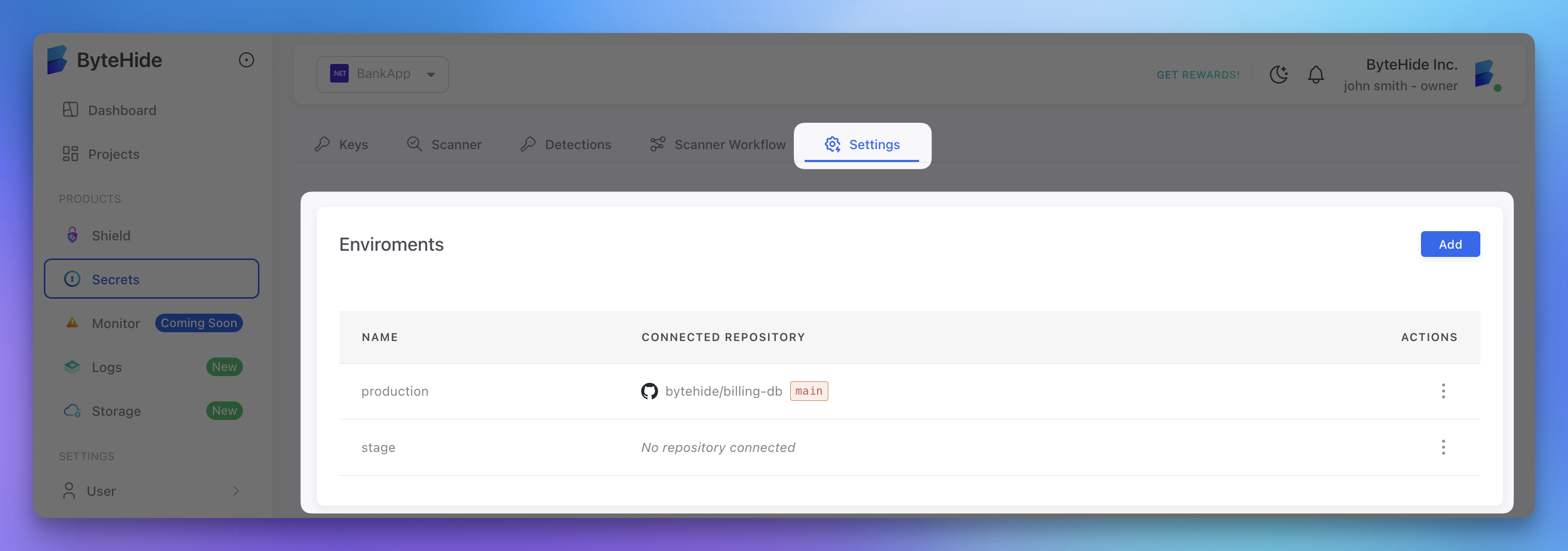Multi-Environment Setup
Environment isolation
ByteHide Secrets allows you to store different values for the same secret key across multiple environments. This ensures proper isolation between development, staging, and production configurations.
Understanding Environments
Environments allow you to manage separate sets of secrets for different stages of your application lifecycle:
- Development: Used during local development
- Staging: For testing before production deployment
- Production: For your live application
- Custom environments: Create any custom environment you need
The key benefit is that your code can use the same secret key across all environments, but retrieve different values depending on the context.
Creating Environments
Environments are created in the ByteHide cloud panel:
- Navigate to your project in the ByteHide Dashboard
- Go to the Settings tab
- In the Environments section, click Add
- Enter a name for your environment (e.g., "staging")
- Optionally connect a repository to this environment
- Click Save
 Click to expand
Click to expand
Setting Environment-Specific Secrets
Once you've created environments, you can set environment-specific values for each secret key:
- Go to the Keys tab in your project
- Click Create secret to add a new secret
- Enter a key name (e.g., "DATABASE_URL")
- Add values for each environment:
- Development:
mongodb://localhost:27017/myapp - Staging:
mongodb://staging-db:27017/myapp - Production:
mongodb://prod-db:27017/myapp
- Development:
- Click Save
 Click to expand
Click to expand
Accessing Environment-Specific Secrets
Set Environment at Initialization
The most common approach is to set the environment when initializing the SDK:
// Set environment via environment variable
// BYTEHIDE_SECRETS_ENVIRONMENT=production
// (No explicit initialization needed if environment variables are set)
// Or directly for testing/development
SecretsManager.unsecureInitialize("your-token", "production");
// Now all secret requests will use "production" environment
const dbUrl = await SecretsManager.get("DATABASE_URL"); // Gets production value
Environment Configuration in Different Scenarios
Local Development
# .env file or environment variables
BYTEHIDE_SECRETS_TOKEN=your-token
BYTEHIDE_SECRETS_ENVIRONMENT=development
Server Deployment
Configure environment variables in your hosting platform:
- Azure App Service: Application Settings
- AWS Lambda: Environment Variables
- Docker: Environment flags
- Kubernetes: ConfigMaps or Secrets
Node.js Express Example
// app.js
import express from 'express';
import { SecretsManager } from '@bytehide/secrets';
const app = express();
const port = process.env.PORT || 3000;
// Environment is determined by BYTEHIDE_SECRETS_ENVIRONMENT var
async function startServer() {
try {
// Get database connection for current environment
const dbUrl = await SecretsManager.get("DATABASE_URL");
// Connect to database
await connectToDb(dbUrl);
app.listen(port, () => {
console.log(`Server running on port ${port} in ${process.env.BYTEHIDE_SECRETS_ENVIRONMENT} environment`);
});
} catch (error) {
console.error("Failed to start server:", error);
process.exit(1);
}
}
startServer();
Front-End Applications
For front-end applications, environment variables are injected at build time:
Webpack Environment Setup
// webpack.config.js
const webpack = require('webpack');
const env = process.env.NODE_ENV || 'development';
module.exports = {
// ...
plugins: [
new webpack.DefinePlugin({
'window.env': JSON.stringify({
BYTEHIDE_SECRETS_ENVIRONMENT: env,
BYTEHIDE_SECRETS_TOKEN: process.env.BYTEHIDE_SECRETS_TOKEN
})
})
]
};
Vite Environment Setup
// vite.config.js
import { defineConfig } from 'vite';
export default defineConfig({
define: {
'window.env': {
BYTEHIDE_SECRETS_ENVIRONMENT: process.env.NODE_ENV || 'development',
BYTEHIDE_SECRETS_TOKEN: process.env.BYTEHIDE_SECRETS_TOKEN
}
}
});
CI/CD Pipeline
In your CI/CD workflows, set the appropriate environment:
# GitHub Actions example
jobs:
deploy:
runs-on: ubuntu-latest
steps:
# ...
- name: Set ByteHide Environment
run: |
# For staging branch
if [[ "${{ github.ref }}" == "refs/heads/develop" ]]; then
echo "BYTEHIDE_SECRETS_ENVIRONMENT=staging" >> $GITHUB_ENV
# For main branch
elif [[ "${{ github.ref }}" == "refs/heads/main" ]]; then
echo "BYTEHIDE_SECRETS_ENVIRONMENT=production" >> $GITHUB_ENV
else
echo "BYTEHIDE_SECRETS_ENVIRONMENT=development" >> $GITHUB_ENV
fi
Best Practices
Environment Naming Convention
Use consistent environment names across your organization:
development(ordev)testing(ortest)staging(orstg)production(orprod)
Value Consistency
Maintain the same key structure across environments with different values:
API_KEY:
- development: "sk_test_123"
- staging: "sk_test_456"
- production: "sk_live_789"
Environment Validation
Validate that the environment exists:
async function validateEnvironment(environment) {
try {
// Try to get any secret with this environment
// This will throw an error if the environment doesn't exist
await SecretsManager.get("API_KEY");
return true;
} catch (error) {
if (error.message.includes("environment not found")) {
throw new Error(`ByteHide environment '${environment}' does not exist`);
}
// Other error
throw error;
}
}
Environment-Specific Logic
Sometimes you need to execute different code based on the environment:
import { SecretsManager } from '@bytehide/secrets';
function getApiBaseUrl() {
switch (process.env.BYTEHIDE_SECRETS_ENVIRONMENT) {
case 'production':
return 'https://api.example.com';
case 'staging':
return 'https://staging-api.example.com';
default:
return 'http://localhost:3000';
}
}
async function getFullConfig() {
const apiKey = await SecretsManager.get("API_KEY");
return {
apiKey,
baseUrl: getApiBaseUrl(),
timeout: process.env.BYTEHIDE_SECRETS_ENVIRONMENT === 'production' ? 5000 : 30000
};
}